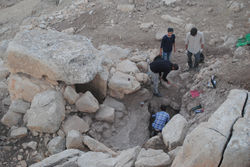Jebel al-Mutawwaq
 |  |  |  |  |
|---|---|---|---|---|
 |
Season 2022
Excavation results of the Spanish-Italian expeditions
In 2022, two areas were excavated: Area EE, located within the fenced area but outside the Early Bronze Age I (EB I) wall near the South Gate, and Area F, situated outside the fence on the eastern edge of the mountain.
Area EE
The aim of the work in Area EE was to complete the excavation of the southern part of Building 1214, a large double-apsed structure first discovered in 2019. The building is located near Dolmen 11 and Cave C.1210. The structure uses the bedrock as its primary floor; however, a raised level made of beaten earth was identified near the southern apse.
Based on the materials recovered—such as mortar, stone tables, a cooking jar, and fired basalt stones—the building was likely a specialized structure, potentially associated with food production during significant religious festivities, such as the veneration of prominent families in the settlement. Notably, a standing stone, typically a cultic element, is integrated into the building's wall. An entrance on the eastern side was also discovered, with a doorway measuring 1 meter in width and featuring three steps descending to the building's floor.
Area F
In Area F, three trenches were opened following a survey prompted by planned destruction of dolmens to make way for luxury villas.
-
Trench 1: Dolmen A, a large dolmen oriented to the north, was excavated. It consists of two walls: the original tumulus and a secondary wall constructed later to reinforce and monumentalize the structure. The space between these walls was filled with stones and rubble, as is customary. The chamber features a back slab and a floor slab from its initial phase. In a subsequent phase, likely a few centuries later but still within EB I, two flat stones and an additional floor slab were added at the end of the frontal corridor, creating a second chamber. The bedrock was exposed and found to have been levelled with compact clay, pebbles, and cobbles to counteract the slope of the mountain. On the eastern side, massive stone slabs were used to stabilize the structure, resulting in a straight tumulus.
-
Trench 2: This trench included Dolmens B and D, which were excavated, and Dolmen C, which was only cleaned due to its collapse from extensive looting.
Dolmen B: The tumulus, composed of regular blocks, is well-preserved, resembling dolmens in the Southern necropolis (EB IB) rather than those in the Eastern necropolis. As with Dolmen A, the bedrock had been levelled to accommodate the slope. The chamber had two phases of use. The second phase is marked by a slab placed atop the original slabs at the entrance and flat stones added at the rear. The first phase is dated to EB IB, while the second phase is attributed to the Middle Bronze Age.
Dolmen D: Although partially collapsed on the western side, Dolmen D features a tumulus similar to Dolmen B and exhibits evidence of levelling. Foundation materials date the structure to EB IB.
-
Trench 3: Dolmen E, the most poorly preserved structure in Area F, was excavated. The dolmen is partially dismantled, but the chamber's structure is discernible. It is divided into two chambers by a central dividing slab. The eastern chamber is entirely dismantled, while the western chamber is better preserved but damaged, including a floor slab that has shifted to one side. Only a tabular scraper was found outside the dolmen, which can be dated to EB I, though it is unclear whether it belongs to EB IA or EB IB.



